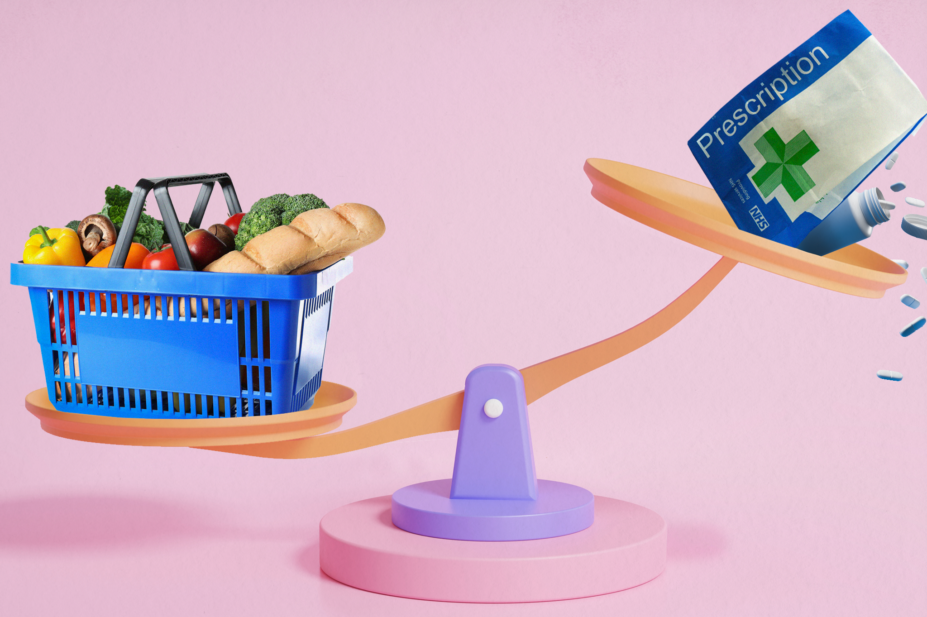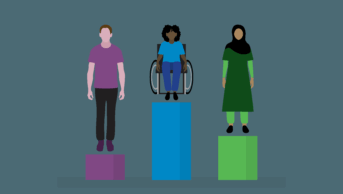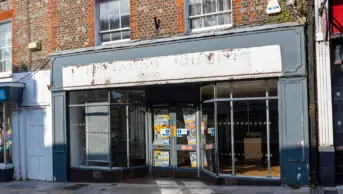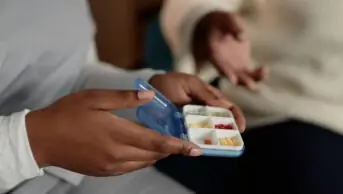
Shutterstock.com/The Pharmaceutical Journal
Pharmacist Ade Williams is very familiar with the hard choices that many patients must make when faced with the cost of their prescriptions.
In his community pharmacy in Bristol — which is in one of the most deprived areas in England — he says it is a “daily experience seeing patients making choices to forgo their own medications or prioritise their limited finance to support a child or more vulnerable family member”.
“I regularly see patients making heartrending choices,” he says, with patients asking: “Do I need to take both medications to control my blood pressure? I cannot afford to pay the charge for my antibiotics and also get Calpol for my children. I will come back if I’m not better.”
It is a reality that many community pharmacists in England will recognise.
England is the only country in the UK to still charge patients for prescriptions, with charges having been abolished in Wales and Scotland in 2007 and 2011, respectively. However, for patients in England, the cost is rising; in March 2023, the government announced an inflationary increase of 3.21%, bringing the prescription charge up to £9.65. And the number of people eligible to pay could increase, following government proposals to raise the upper age exemption for free prescriptions from 60 to 65 years.
The cost of living crisis is having an impact on people’s healthcare choices
Gareth Jones, director of external and corporate affairs at the National Pharmacy Association
In its impact assessment for the proposals, the government acknowledges the potential “deterrent effect” of the charges, saying that “the number of people who could be affected, that is, the number of people who have a long-term condition who are not covered by a medical or income-related exemption, is approximately 15% of prescription users”.
It admits that the charges “can have serious negative impacts” on the health of these patients.
Even before this latest price hike, the Royal Pharmaceutical Society (RPS) surveyed 269 community pharmacists in England at the end 2022 and discovered that more than half (51%) said they have seen an increase in the number of patients not collecting prescriptions in the past six months, while 52% said they had seen an increase in the number of patients asking whether they can “do without” certain medicines owing to the prescription charge.
In March 2023, a survey of 4,014 people with long-term conditions carried out by the Prescription Charges Coalition, a campaign set up to abolish the prescription charge for people with long-term conditions, found that 1 in 10 (9%) were not able to collect their prescriptions in the past 12 months because of the cost. With 15 million people in England living with long-term conditions, this could equate to hundreds of thousands of people going without medicines they need.
Gareth Jones, director of external and corporate affairs at the National Pharmacy Association (NPA), says surveys such as these show that the current “cost of living crisis is having an impact on people’s healthcare choices”.
The British public has been in the grip of rising price inflation for basic necessities since late 2021, as global supply chains were strained following the COVID-19 pandemic.
Wages, meanwhile, have not kept pace. The Office for National Statistics (ONS) reported that average total pay grew by just 5.9% year-on-year, from December 2022 to February 2023. As a result, an ONS survey of 2,040 people revealed that 93% said their cost of living has increased over the year to May 2023, with 48% saying they are now buying less food and 49% saying they are using less fuel in their homes to manage the cost increases.
No one should have to make choices about rationing their medicines
Thorrun Govind, chair of the Royal Pharmaceutical Society English Pharmacy Board
While the vast majority of prescription items — 95% according to the latest data — are dispensed to patients who meet 1 of 15 criteria that entitles them to a free prescription (see Box), Jones says the exemption system is still not fair.
“The NPA is part of the Prescription Charges Coalition, seeking reform of the outdated, illogical and unfair system of prescription charges in England. Prescription charges can deter people from getting the medicines they are prescribed, especially people on low, fixed incomes,” he says.
“Not only would getting rid of prescription charges benefit patients, but it would free up time for pharmacists, who, like other healthcare professionals, want to spend it with their patients, not on paperwork.”
Thorrun Govind, chair of the RPS English Pharmacy Board, adds: “The RPS has long campaigned to remove prescription charges for people with long-term conditions in England, because they create a financial barrier to patients receiving the medicines needed to keep them well and no one should have to make choices about rationing their medicines.”
Yet surveys carried out by specialist charities for people with long-term conditions show that many are having to make these choices. Results from a survey published in 2022 by the charity Asthma + Lung UK of 3,600 people with lung conditions, such as asthma, chronic obstructive pulmonary disease and bronchiectasis, showed that almost 1 in 6 people (15%) are using their inhaler less frequently to make it last longer, while 1 in 5 people with asthma said cutting back on medicines, heating and food has caused “life-threatening asthma attacks”.
Meanwhile, results from a survey by the MS Society, published in September 2022, showed that 1 in 5 people with multiple sclerosis said they do not have enough money to pay for the medicine they need, with 62% of respondents adding that this has had a negative impact on their memory and thinking.
However, using survey data can be misleading, so The Pharmaceutical Journal requested actual data from the NHS Business Services Authority (NHSBSA), through a freedom of information request, about the actual proportion of prescription items that were requested but not dispensed by community pharmacies in England.
The data revealed that the number of prescription items pharmacists are marking as ‘not dispensed’ has increased by 18.2% between 2021/2022 and 2022/2023 — when the cost of living crisis began. This sharp increase follows a two-year decline in the number of items endorsed as ‘not dispensed’ between 2019/2020 and 2021/2022, when 5,861,258 items and 4,841,474 items were not dispensed, respectively. The number of undispensed items then increased to 5,720,529 in 2022/2023 (see Figure 1).
This rise may be for several reasons, says the Pharmaceutical Services Negotiating Committee, such as a patient no longer requiring the prescription; the patient being unable to pay the prescription charges and so choosing not to take it; or if the product is unavailable owing to medicines shortages — another phenomenon on the rise in the past 12 months.
“From my experience, the reason there have been so many ‘ND’ [‘not dispensed’] items is the shortages and stock issues,” says Reena Barai, who runs SG Barai Pharmacy in Sutton, London.
“We can’t get so many meds, or if we get them, they are above [drug tariff] reimbursement, so many of us are getting alternative Rx [prescriptions] for replacement products that are available or are under price concession/drug tariff price. Hence, we ‘ND’ the original item.”
Barai adds that prescribing errors will also account for a portion of the items marked as ‘not dispensed’. “I notice this with hospital discharges, in particular, as my area doesn’t do the DMS [discharge medicines service], sadly, and we see errors in prescribing post discharge the most.”
However, Barai says there is “a cohort of patients who don’t get meds as they can’t afford them or wait to collect them after they have been paid”.
“I think the usual medicines include preventer inhalers, where people pay for their reliever (salbutamol) but don’t take their steroid preventer one,” she said.
Additional data analysis by The Pharmaceutical Journal, using the government’s index of income deprivation, has also revealed that the increase in items endorsed as ‘not dispensed’ has disproportionately impacted patients whose incomes are lower, but not low enough to qualify for income support programmes that would make them eligible for free prescriptions.
The index ranks small local areas from one to ten based on the proportion of people in those areas who are on low incomes and, therefore, receive benefits and tax credits. Areas with the highest proportion of people on this income support, such as Universal Credit and Jobseeker’s Allowance, have a ranking of ‘one’.
This could exacerbate societal and health inequalities if those on poorer incomes (but not eligible for free prescriptions) have to pay for the drugs they need
Azeem Majeed, professor of primary care and public health at Imperial College London
Our analysis shows that pharmacies located in areas of England that have the second-highest proportion of people on income support — people who are likely to be on low incomes but do not receive benefits — saw the number of ‘not dispensed’ endorsements increase by 26% in the past year, from 718,081 items in 2021/2022 to 904,733 items in 2022/2023 (see Figure 2).
Pharmacies in areas with the highest proportion of people receiving this type of support — and who would also qualify for free prescriptions — saw a 15% increase in the number of items marked ‘not dispensed’, from 686,218 item in 2021/2022 to 789,641 in 2022/2023.
This suggests that prescription charge exemptions are missing a cohort of the population that still desperately needs them, forcing them to pay for medicine that they cannot afford.
“Most NHS prescriptions … are issued to patients who are eligible for free prescriptions. However, for those who have to pay, the NHS prescription charge can be a significant financial burden,” says Azeem Majeed, professor of primary care and public health at Imperial College London.
“This could exacerbate societal and health inequalities if those on poorer incomes (but not eligible for free prescriptions) have to pay for the drugs they need.”
The government has poured millions of pounds into attempts to eliminate health inequalities that it already described as “striking” in its ‘Levelling up’ white paper, published in February 2022, having found that hospital admissions and mortality rates are higher among more deprived groups.
In 2022/2023, integrated care boards were given £200m to help meet specific targets relating to NHS England’s Core20PLUS5 initiative, which is aimed to focus on people living in the 20% most deprived areas and identifies five clinical areas for improving health inequalities: maternity, severe mental illness, chronic respiratory disease, early cancer diagnosis and hypertension case-finding.
Then, in May 2023, the government committed £645m towards setting up a ‘Pharmacy First’ service in England, which will enable pharmacists to supply prescription-only medicines for seven common conditions, with the expectation that the plans will improve access to healthcare in deprived areas.
Williams compares the effect of prescription charges on health inequalities to “using a basket as a watering can and wondering why it takes so long and much effort” to create equity.
“The prescription charge in England is a barrier to delivering equitable health,” he says. “It fails to make sense that we spend a lot of resource, time and expertise in a laudable effort to remove access barriers and inform communities who are failing to come and receive care and then to put a health levy on the treatment they require.”
And yet the government appears to have no plans to change tack. When asked to comment on the data from NHSBSA, a spokesperson for the Department of Health and Social Care said: “Almost nine out of every ten prescriptions are dispensed free of charge in England. Patients with long-term conditions or on a low income can apply for a range of prescription charge exemptions or additional support through the NHS Low Income Scheme.
This undermines patients’ care and if their health worsens because they have not filled their prescription, patients may need even more NHS care
Rachel Power, chief executive of the Patients Association
“There are a number of reasons why prescriptions may not be dispensed so it is important not to ascribe all to one cause.”
But Rachel Power, chief executive of the Patients Association, says the data “do suggest that patients are making decisions about whether or not to collect their prescriptions based on finances rather than their health needs”.
“This undermines patients’ care and if their health worsens because they have not filled their prescription, patients may need even more NHS care.”
If the government continues to pursue its priorities of “cutting NHS waiting lists” and “levelling up”, it cannot afford for any medicines to be withheld based on a person’s income.
Box: Who is entitled to free prescriptions?
Patients who fall under the following categories are eligible for free prescriptions:
- Aged 60 years or over;
- Aged under 16 years;
- Aged between 16 and 18 years and in full-time education;
- Are pregnant or have had a baby in the previous 12 months and have a valid maternity exemption certificate (MatEx);
- Have a specified medical condition and have a valid medical exemption certificate (MedEx);
- Have a continuing physical disability that prevents them going out without help from another person and have a valid medical exemption certificate (MedEx);
- Hold a valid war pension exemption certificate and the prescription is for their accepted disability;
- Are an NHS inpatient;
- Are entitled to or named on a valid NHS tax credit exemption certificate;
- Are entitled to or named on a valid NHS certificate for full help with health costs (HC2).
Patients are also entitled to free prescriptions if they or their partner receive, or they are under the age of 20 years and the dependant of someone receiving:
- Income Support;
- Income-based Jobseeker’s Allowance;
- Income-related Employment and Support Allowance;
- Pension Credit Guarantee Credit;
- Universal Credit and meet the criteria.
Source: NHS England

Health inequalities
The Royal Pharmaceutical Society’s policy on health inequalities was drawn up in January 2023 following a presentation by Michael Marmot, director of the Institute for Health Equity, at the RPS annual conference in November 2022. The presentation highlighted the stark health inequalities across Britain.
While community pharmacies are most frequently located in areas of high deprivation, people living in these areas do not access the full range of services that are available. To mitigate this, the policy calls on pharmacies to not only think about the services it provides but also how it provides them by considering three actions:
- Deepening understanding of health inequalities
- This means developing an insight into the demographics of the population served by pharmacies using population health statistics and by engaging with patients directly through local community or faith groups.
- Understanding and improving pharmacy culture
- This calls on the whole pharmacy team to create a welcoming culture for all patients, empowering them to take an active role in their own care, and improving communication skills within the team and with patients.
- Improving structural barriers
- This calls for improving accessibility of patient information resources and incorporating health inequalities into pharmacy training and education to tackle wider barriers to care.


